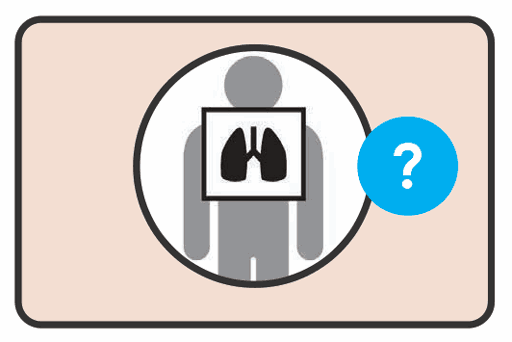Book traversal links for 3.1.2 CXR screening

CXR is a rapid imaging technique for identifying lung abnormalities. It is used in clinical evaluation for conditions of the thoracic cavity, including the airways, ribs, lungs, heart and diaphragm. CXR is a good screening tool for pulmonary TB because of its high estimated accuracy for detecting TB disease, especially before the onset of symptoms. From the perspective of the person being screened, CXR is valuable because it can also detect medical conditions other than TB, including other pulmonary and thoracic conditions.
The sensitivity of CXR for the threshold of any abnormality is estimated to be 94%, and its specificity is estimated to be 89% (Table 3.1). For a threshold of an abnormality suggestive of TB, the estimated sensitivity is lower (85%) but the specificity is higher (96%). Thus, either “any abnormality” or “abnormality suggestive of TB” detected by CXR can be used, depending on the context, radiological expertise, the availability of other resources, including diagnostic testing, and a preference for higher sensitivity or for higher specificity of the screening algorithm.
Although CXR is the preferred screening tool from the viewpoint of test accuracy, it can be expensive and logistically challenging to use, especially during active case finding, when screening is done as an outreach activity outside the health services. It is important to keep in mind that people may have to travel away from their usual facility for a CXR and to pay for it out of pocket. CXR is a good choice in most screening scenarios, particularly those based in a healthcare setting or where mobile X-ray technology can be used, but it is not feasible in some scenarios.
Implementation considerations for CXR as a screening tool
Equipment and resources
- Implementation of CXR requires equipment. Consider the resources required (budget, health workforce, personal protective equipment, imaging equipment).
- Ensure the functioning of radiography equipment and establish a mechanism for regular maintenance for optimal functioning of the equipment.
- Portable chest radiography equipment can increase access to TB screening for eligible populations outside the health centre (31).
Digital technology
- Favour digital radiography equipment to increase access to CXR screening, as the throughput can be higher and the time for processing shorter and it will reduce the environmental impact of used films and printing. Newer radiography technology emits lower doses of radiation and may be much more portable (31).
- Comparison of multiple CXR images for the same individual over time can aid diagnosis. If appropriate technology and processes are available, archiving and retrieval of digital images may be more convenient than for physical films.
- Consider the transfer of images for remote reporting (teleradiology) and CAD of TB on digital radiographs as necessary to broaden implementation of CXR for screening (e.g. in settings where radiologists are not available for on-site reporting, or their availability is scarce).
Skilled CXR reading and interpretation and appropriate follow-up
- Provide appropriate training of radiologists and technologists to maximize the accuracy of reading of images by accepted local protocols.
- Develop standard operating procedures for use of CXR and for appropriate follow-up, including for abnormalities associated with diseases other than TB.
- Develop job aids to assist providers in informing the test recipient and to respond to frequently asked questions about the utility and procedure of CXR.
- Strengthen mechanisms for supportive supervision and monitoring of accurate implementation.
- Develop tools for systematic recording and reporting of CXR findings and linkage to confirmatory diagnostic testing.
Access
- Consider providing funding for people to travel for CXR screening or using mobile screening to improve access to CXR screening (32).
- Patients should not have to make out-of-pocket payments for CXRs performed as part of TB screening. Consider removing patient costs for CXR entirely or using vouchers to further reduce barriers to accessing this critical tool for TB control.
Safety of radiation
- Radiography involves exposure to some ionizing radiation, which may increase the long-term risk for cancer. Recent innovations in radiography have substantially reduced exposure to radiation. CXR is largely considered safe at a radiation dose of 0.1 mSv, which corresponds to 1/30 of the average annual radiation dose from the environment (3 mSv) and 1/10 of the annual accepted dose of ionizing radiation for the general public (1 mSv). Manufacturers provide information on doses in technical specifications of the machine being used.
- When performing CXR, minimize the radiation dose while maintaining diagnostic image quality (e.g. low-dose scanning protocols); use digital imaging rather than film-screen equipment.
- Lead shields can be used to reduce exposure to ionizing radiation of other parts of the body. While lead shields are preferred, they are not a requirement for conducting CXR as part of TB screening, and exposure to ionizing radiation can be minimized in other ways.
- Pregnant women are especially vulnerable to ionizing radiation from radiography. CXR does not pose any significant risk for pregnant women or the fetus, provided that good practices are observed, with the primary beam targeted away from the pelvis. Children have a longer life expectancy and therefore more time to develop radiation-induced health effects within their lifetime.
- Inform the person who is screened about the safety provisions for radiation protection.
For more resources on use of CXR for TB screening
- WHO Chest radiography in TB detection: https://apps.who.int/iris/handle/10665/252424 (33)
- TB prevalence surveys: a handbook: https://www.who.int/tb/advisory_bodies/impact_measurement_ taskforce/resources_documents/thelimebook/en/ (35)
 Feedback
Feedback